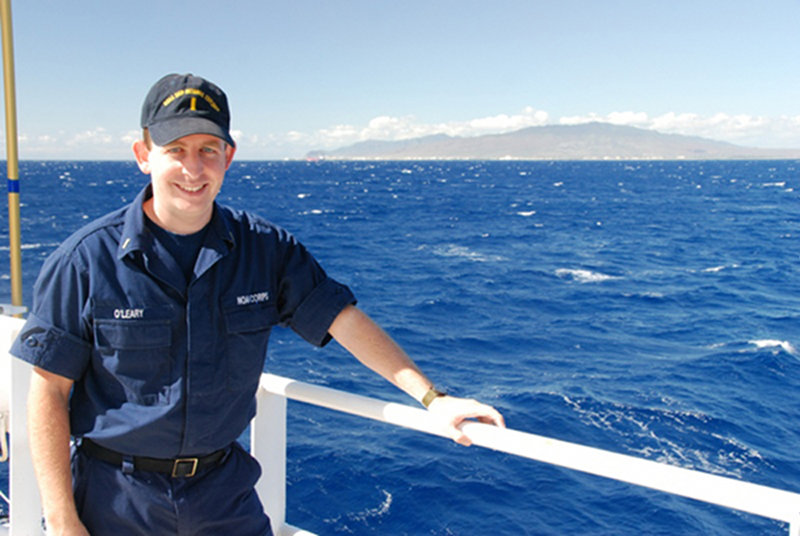
By LTJG Matt O'Leary, Navigation Officer - NOAA Ship Okeanos Explorer
August 2, 2011
As an officer aboard the NOAA Ship Okeanos Explorer, my job is rarely dull or uneventful. Whether it’s watching live, high-definition footage from an unexplored area of the sea floor, taking part in the discovery of lifeforms new to science, navigating the ship through beautiful parts of the world, or just watching a sunset from the bow, there’s always something to keep the job fun and exciting.

Matt O’Leary aboard the NOAA Ship Okeanos Explorer. Image courtesy of NOAA Okeanos Explorer Program. Download image (jpg, 96 KB).
My name is LTJG Matt O’Leary, and I’m the Navigation Officer aboard the NOAA Ship Okeanos Explorer. My job mainly involves standing bridge watch and ensuring the safe navigation of the ship. One of the most fun parts of being aboard this ship is getting to travel throughout the world. There are certain experiences that all mariners hope to have throughout their career, such as crossing the International Date Line, crossing the equator, or crossing the Arctic Circle. This past week I was lucky enough to have one of those experiences: taking a ship through the Panama Canal.
The Panama Canal is an engineering marvel even today, and is only more amazing when you remember that it was first opened in 1914. The canal itself consists of three sets of locks and a large lake in the middle. The purpose of the locks are to first raise the ship up to the level of the lake – about 85 feet above sea level – and then lower the ship back down to sea level. If you watch the accompanying time-lapse video, you can see the ship going through the first two sets of locks. By the end of the video, the ship has been lifted all the way up to the lake level.
The Panama Canal consists of three sets of locks and a large lake in the middle. The purpose of the locks are to first raise the ship up to the level of the lake – about 85 feet above sea level – and then lower the ship back down to sea level. This time-lapse video shows NOAA Ship Okeanos Explorer going through the first two sets of locks. By the end of the video, the ship has been lifted all the way up to the lake level. Video courtesy of NOAA Okeanos Explorer Program, MCR Expedition 2011. Download (mp4, 9.5 MB).
Every ship that goes through the canal is required to have a Panama Canal Pilot onboard. These pilots are men and women who know the canal better than anyone else – they each take, on average, over 150 ships through the canal per year. Having a pilot onboard helps ensure that the ship makes it through safely.
For our transit, we were lucky enough to have a pilot who allowed my fellow junior officers and me to Conn the ship while we were between locks, even though we were transiting at night. The ship’s Conn is the person who gives helm and engine orders – in other words, he or she gets to decide exactly where the ship goes and how fast it gets there. The pilot kept a close eye on us and constantly offered advice, but he allowed us to give the orders to the helmsmen. This was an experience none of us will ever forget. The canal is lit very well with buoys and range markers (large lights that help show you the proper course to steer), but it still requires a combination of skill and local knowledge to get the ship through safely. The transit took about 10 hours total, but with so much going on the time seemed to fly by.
There are many other exciting places to go and experiences to have, but I am already looking forward to the next time I get to take a ship through the Panama Canal. The canal is one reason why my job as a NOAA Corps Officer will never be boring.